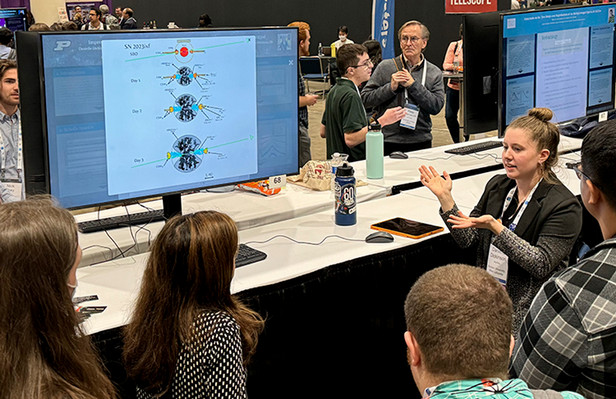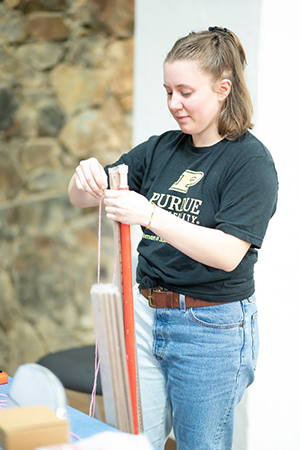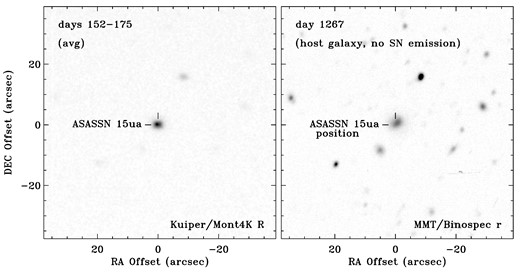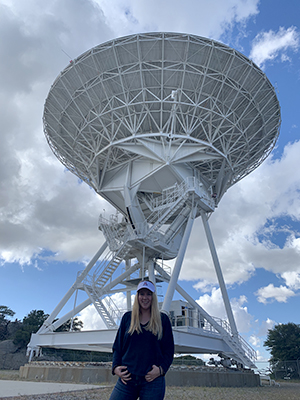
Student Spotlight: Danielle Dickinson
Years of core collapse supernovae research results in stellar autopsy of ASASSN-15ua
Story by Cheryl Pierce

It’s been a stellar year for PhD student Danielle Dickinson. She was awarded the Chambliss Astronomy Award for a presentation at the American Astronomical Society convention this past December. This award is only granted to the top one percent of students who present. She also spent time in Colombia with Physics and Astronomy K-12 Outreach for the Saturday Morning Astrophysics program. In addition to all this, she published her premiere first-author paper for a supernova she has been researching since she was an undergrad.
Dickinson specializes in core collapse supernovae. These supernovae begin as giant stars that explode into collapse into the code. As molecules fuse inside the star, eventually the star cannot support its own weight and gravity forces the star to collapse into itself. Her publication appeared in the Monthly Notices of the Royal Astronomical Society and focuses on ASASSN-15ua which she has studied since she was an undergrad at Arizona State.
According to Dickinson, the star that exploded as ASASSN-15ua spent the last 12 years of its life losing mass. Some eruptive mechanism caused gas to come off of the star at a rate of one solar mass per year! When the supernova happened, the explosion ran into this “circumstellar material” around the star.
“My paper serves as a sort of stellar autopsy,” she says. “I use spectroscopy to understand how fast the circumstellar material is moving, and I make estimates of how and when that mass was lost. We don’t know why massive stars undergo these crazy mass loss events so close to the time of stellar death. It’s like the star knows it’s going to die. There are several well-studied examples, and the wind speeds and strengths vary considerably. Since they are all over the place, it’s hard to pin down exactly what is causing it. My study contributed another of these objects to the sample, and I found that this object fell in the middle of the observed parameter space. This suggests a continuum of behavior, ie: one thing is causing a large diversity of behavior. I discuss many possible mechanisms for the mass loss, but I think binary interaction between massive stars is very important in this mass loss process.”

ASASSN stands for the All-Sky Automated Survey for Supernovae, and it’s run by The Ohio State University. This object exploded in 2015, and it was given the extension “ua” because ASASSN found a lot of objects before it. ASASSN-15a would be the first object found in 2015. ASASSN-15b is the second, ASASSN-15aa is the 27th, etcetera.
“I think the star that made ASASSN-15ua was a luminous blue variable (LBV). These are the monsters of the universe,” explains Dickinson. “They can be upwards of 100 times the mass of our sun. These stars burn so bright and so hot that they are very puffy and hardly bound together. We see in the literature that these stars are born less massive, but they feed off a companion star or completely merge with it, creating a rejuvenated star. Astronomers during Halloween like to call them vampires, but this is actually a very fair comparison. They are much older than they look. Because they are loosely bound, extremely hot, and in multiple-star systems, there are many reasons why mass would be eruptively lost from them. They are really, really awesome!”
Data for this publication was gathered using the SuperLOTIS Telescope, Kuiper 61” Telescope, the Large Binocular Telescope, the MMT Observatory, and the Bok 2.3-meter Telescope. All of these facilities are run by the University of Arizona. Dickinson initially became interested in astronomy and these facilities while an undergrad at the University of Arizona. They even featured her and her research in a video while she was there.
“I also have data from PANSTARRS,” she says. “The SuperLOTIS data and PANSTARRS are open source, so anyone can access them. There are also light curves from ASASSN and the Catalina Sky Survey’s Transient Survey (CRTS) out there that are publicly available, although I do not present that data in my paper.”
Her publication was supported in part by the Rolf Scharenburg Graduate Fellowship and her advisor, also a co-author on the paper, Danny Milisavljevic. The Rolf Scharenberg Graduate Fellowship was established in 2017 through the generosity of Wendell and Nancy Lutz in memory of emeritus professor Scharenberg. The fellowships allow first- or second-year graduate students to work with a research advisor for a summer prior to joining a research group permanently. Dickinson worked on the research for this publication during the summer of 2022 in relation to the fellowship.
“Danielle’s passion ignites discovery, her intellect forges new paths, and her dedication inspires excellence in us all,” says Milisavljevic.
She describes her research with ASASSN-ua as in “good but rough shape” when she arrived at Purdue. She considers herself lucky to be working with Milisavljevic and given the resources at Purdue to continue the research she began elsewhere. She also credits Katie Weil (postdoc), Paul Duffell, and Bhagya Subrayan for helping get this publication ready.
“They gave me a lot of support and advice to get this thing off the ground. It was a big Purdue effort, but I also received a lot of support from my coauthors, namely Nathan Smith and Jen Andrews,” she says. “I’m really happy this paper is out, and I am very proud of the academic arc that it represents. I started this project in August 2018, and it was published Dec 13, 2023. I have grown a lot as a person and as an astronomer and everyone on the paper, coauthors and those in the acknowledgements, were part of that!”

Although this is her first first-author paper, the sky is the limit for Dickinson. One should expect many more to come as she perfects her next giant leaps in supernovae research.
“I study astronomy because it is breathtaking. Especially with the images from JWST, astronomy is beautiful, big, and exciting,” she says. “I learned about Pulsar Timing Arrays in high school and found that they are a probe for gravitational waves! I was fascinated by the fact that mass could literally bend time and space. Like, wow! There is a Pulsar really far away, and I am being stretched by it! Once I took my first observational astronomy course my freshman year of undergrad, I was locked in. Light spends tens to thousands to millions of years to travel from a star to my eyes. It is a beautifully humbling history lesson. I love studying supernovae because they are element factories. I am thankful for the white dwarf that exploded billions of years ago for the Iron in my blood, and I am thankful for the massive star that exploded and made the gold in my earrings! I continue to be bewildered by nature, and I plan on continuing to study astronomy in academia.”